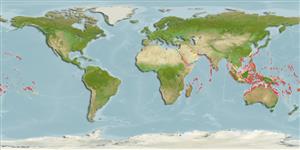Common names from other countries
>
Blenniiformes (Blennies) >
Blenniidae (Combtooth blennies) > Salariinae
Etymology: Exallias: Greek, exallias = strange, marvellous (Ref. 45335).
More on author: Kner.
Environment: milieu / climate zone / depth range / distribution range
Ökologie
seewasser riff-verbunden; tiefenbereich 3 - 20 m (Ref. 9710), usually 3 - 8 m (Ref. 58302). Tropical; 30°N - 30°S
Indo-Pacific: Red Sea south to Sodwana Bay, South Africa (Ref. 4404) and east to the Hawaiian, Marquesan, and Society islands, north to the Ryukyu and Bonin islands, south to New Caledonia and Rapa.
Size / Gewicht / Alter
Maturity: Lm ? range ? - ? cm
Max length : 14.5 cm TL Männchen/unbestimmt; (Ref. 9710)
Rückenflossenstacheln (insgesamt) : 12; Rückenflossenweichstrahlen (insgesamt) : 12 - 13; Afterflossenstacheln: 2; Afterflossenweichstrahlen: 14 - 15. Numerous papillae on the upper lip, smaller and more closely spaced spots. Nuchal cirri: 30 - 36.
Adults occur on clear coastal reefs, often in bays and semi-exposed habitats (Ref. 48636). Found on the seaward edge of reefs, among corals like Acropora, Pocillopora, Seriatopora, Porites, and Millepora where they feed on coral tissues (Ref. 1602). Benthic (Ref. 58302). Males prepare nesting sites by overgrazing a patch of coral (Ref. 9710). Oviparous. Eggs are demersal and adhesive (Ref. 205), and are attached to the substrate via a filamentous, adhesive pad or pedestal (Ref. 94114). Larvae are planktonic, often found in shallow, coastal waters (Ref. 94114). Minimum depth reported taken from Ref. 30874.
Life cycle and mating behavior
Maturities | Fortpflanzung | Spawnings | Egg(s) | Fecundities | Larven
Oviparous, distinct pairing (Ref. 205).
Myers, R.F., 1991. Micronesian reef fishes. Second Ed. Coral Graphics, Barrigada, Guam. 298 p. (Ref. 1602)
IUCN Rote Liste Status (Ref. 130435)
CITES (Ref. 128078)
Not Evaluated
Bedrohung für Menschen
Harmless
Nutzung durch Menschen
Fischereien: kommerziell; Aquarium: Kommerziell
Tools
Zusatzinformationen
Download XML
Internet Quellen
Estimates based on models
Preferred temperature (Ref.
115969): 24.7 - 29.3, mean 28.3 (based on 3063 cells).
Phylogenetic diversity index (Ref.
82804): PD
50 = 1.0000 [Uniqueness, from 0.5 = low to 2.0 = high].
Bayesian length-weight: a=0.01995 (0.00906 - 0.04395), b=3.01 (2.83 - 3.19), in cm Total Length, based on all LWR estimates for this body shape (Ref.
93245).
Trophic level (Ref.
69278): 4.3 ±0.4 se; based on diet studies.
Widerstandsfähigkeit (Ref.
120179): hoch, Verdopplung der Population dauert weniger als 15 Monate. (Preliminary K or Fecundity.).
Fishing Vulnerability (Ref.
59153): Low vulnerability (10 of 100).
